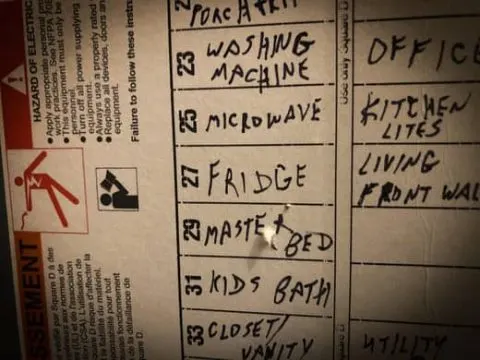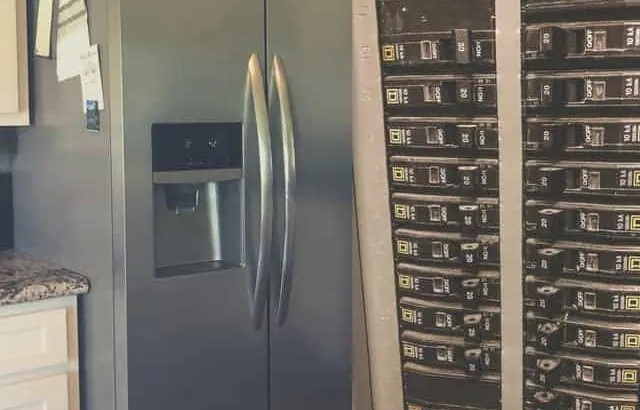A refrigerator will lose power from a tripped breaker, sometimes for hours before you realize it. Obviously, a reoccurring problem like this needs attention.
Why a refrigerator keeps tripping a breaker? The primary causes of a refrigerator repeatedly tripping a breaker are:
- an overloaded circuit
- a short circuit
- a ground fault surge
All of these problems can cause fires and/or electrocution if not properly addressed.
This article will first outline the mechanics of circuit breakers, outlets, and refrigerator components. Next, we will discuss just what the main circuitry problems are telling you. And finally, we will walk you through a step-by-step troubleshooting guide and give solutions to the most common reasons your refrigerator is losing power.
Mechanical and Electrical Components
Let’s start our discussion with the mechanical and electrical components involved in circuit breakers, outlets, and basic refrigerator mechanisms that can be involved in circuit breaker tripping. I will start at the breaker box.
Circuit Breaker: Circuit breakers are attached to all of the wiring in a building or home and act as safeguards against power surges and other electrical issues.
Whether from constant, slow heating, or from a sudden power surge, the circuit is designed to break the current when it is overloaded.
Wiring Basics: Three electrical connections make up the standard appliance wiring that connects to your home’s electrical system. The hot wire carries the 120 volt current to your appliance and the neutral wire serves as the return path in the circuit. These run through the 2 thinner prongs on power cords.
The third prong connects the ground wire, which is simply attached to the metal casing of the appliance. This ground wire will take the 120 volts if the hot wire shorts, causing an extremely high current that trips the breaker.
The ground wire is incredibly important because, without it, the entire appliance can become one big shock hazard (source).
GFCI Outlet: A Ground Fault Circuit Interrupter works like an ultra-sensitive circuit breaker. The appliance is plugged into the outlet, and when even a few amps of surge are detected, the circuit within the outlet will trip.
These outlets are used in bathrooms and other areas where water is present for protection against electrocution. They protect someone from electric shock should a short circuit or ground fault occur.
Refrigerator Defrost Heater: The defrost heater is a resistance element located in the evaporator compartment to melt ice built up on the coils of the refrigerator. It is attached to a timer and thermostat that work to regulate the temperature and cycling of the defrost heater and compressor (source).
Refrigerator Compressor: The compressor works as both a motor and a pump, moving refrigerant throughout the system coils to cool the temperature in the fridge. It is the powerhouse of the appliance and the most expensive component to replace.
What Is Happening in My Circuitry to Cause Tripping?
It is important to have an understanding of what is happening in the circuitry. Circuit breakers trip to stop the flow of electricity and indicate that something is going wrong. Figuring out where the problem lies can save property and life.
- Overloaded Circuit: An overloaded circuit occurs when too many amps are running through the same wiring. Residential code allows 20 amps per circuit (source). If more amps attempt to flow through a circuit, this can cause overheating and power surges that damage wiring and appliances.
- Short Circuit: A short circuit occurs when the hot wire (wire with electricity flowing though it) contacts the neutral wire. This causes too much heat as electricity surges through the wires. You may notice a burning smell or burnt wiring.
- Ground Fault Surge: A ground fault surge occurs when the hot wire and the ground wire connect. This also causes overheating and can discolor the area around the outlet.
Pro Tip: You can use a circuit breaker finder (link to Amazon) to quickly identify which circuit breaker is powering the refrigerator.
Step-by-Step Troubleshooting Guide
Now that you have an idea of how the components work and basic circuitry issues, I want to walk through all the different reasons for a refrigerator tripping a circuit breaker and what to do about them.
I will start with the most obvious, simple fixes and work up to the more complicated problems.
- Check the GFCI outlet: If you have lost power to your refrigerator, and it is plugged into a GFCI outlet, the outlet may have tripped due to nuisance tripping. GFCI outlets are very sensitive and designed to trip at slight surges.
However, most fridge manufacturers do not recommend plugging into a GFCI outlet and they are not required for appliances (source).
Why? Refrigerators require a large amount of power to begin their cooling cycles—and very often trip GFCI outlets. See this video for more information:
If you do have a GFCI outlet and it has tripped, reset it. If the outlet now works, you can eliminate the GFCI outlet as the problem. Move the plug to a different, non-GFCI outlet. Moving to a different power source may be the end of your issues.
Note: GFCI outlet tripping should not also trip a circuit breaker in your breaker box. If that has happened, keep exploring. You have a bigger problem and should keep troubleshooting to the next step.
- Power cord inspection: This may seem like a no brainer, but damage to the refrigerator power cord can cause short circuits. Unplug the cord and inspect the length of the cord for worn insulation, crushed wiring, or indication of animal damage (such as rat chews).
If you see any damage where the wires inside are exposed, the cord needs to be replaced. Many people suggest wrapping it with electrical tape but I don’t recommend this.
If no damage, move to step 3.
- Inspect the prongs of the power cord: Are they rusty, loose, or broken? If so, you could have ground fault surges or faulty connections that are causing power surges. Replace the plug unit or the whole cord system. Power cord intact? Move to step 4.
- Check for an overloaded circuit: If multiple appliances are plugged into the same circuit, it could become overloaded, especially when the refrigerator compressor starts.
Try plugging the refrigerator into another outlet, maybe even in another room to ensure it is attached to a different circuit. I’ve done this by running an extension cord to another room when troubleshooting.
If the refrigerator is able to run its cycles with no tripping, you may need to figure out what other appliances are normally attached through this circuit and eliminate them.
Refrigerators should be on a dedicated circuit when possible. I will tell you that I always place all appliances on their own circuit. Not only does this help prevent overload, but it also greatly reduces the number of potential causes when troubleshooting.

Make sure electrical power is disconnected before performing steps 5 and 6. If you aren’t knowledgable about electrical, hire a professional.
- Inspect Outlet: In addition to checking for an overloaded circuit, inspect the power outlet where you normally plug the fridge for damage. Remove the receptacle cover and look for loose or burnt wiring.
If there is no visible damage, test wires with an ammeter. Faulty wiring in the outlet can cause short circuits and ground faults. Replace the outlet if necessary. Still no issues detected? Move to step 6.
- Breaker Box Inspection: If you have discovered no damage to the power cord or outlet, check the breaker box itself. Circuit breakers can wear out or suffer damage from water or pests. Inspect the breakers—does anything look corroded, cracked, or worn?
If you suspect damage at the breaker box, replace the suspect circuit breaker or call an electrician. If all looks well at the box, return to the fridge itself.
- Check wiring on refrigerator unit: Unplug the fridge and pull away from the wall. Remove the rear paneling and inspect and test wires for loose or faulty connections. If nothing is obvious, move to step 8.
- Test defrost heater: The most common internal component to fail in a refrigerator is the defrost heater. Thankfully, it is a relatively inexpensive part to replace.
To troubleshoot it, reset the timer (usually changed with a screwdriver) so that you can force the defrost cycle to begin.
If the breaker trips shortly after the cycle begins, then the defrost heater is either water-damaged (a common problem), causing a ground fault, or short-circuiting from insulation damage.
Replace the defrost heater, a reasonably simple DIY project. If the defrost heater seems to be functioning properly, move to step 9.
- Compressor Check: If nothing else has been pinpointed as the problem for the reoccurring circuit breaker trips, the compressor is probably at fault.
When the compressor winding begins to fail, the extra power load normally needed to start winding doesn’t stop after a few seconds. The extra power overloads and trips the breaker. Refrigerator compressors are expensive fixes.
You can call an appliance mechanic for repairs, but you are probably better off purchasing a new unit to replace what you have.
Recommended Reading: What Appliances Are Worth Upgrading? Here’s The Math!
Conclusion
Circuit breaker tripping can be a an annoying problem, but it is also an indication of potentially dangerous electrical issues within your home. To protect your property and family, it is imperative to address the recurring problem.
If your refrigerator loses power from a circuit breaker trip, realize that most circuit breakers trip from overloaded circuits, short circuits, or ground fault surges. By investigating all of the components between the unit and the circuit breaker, you can usually pinpoint and solve the problem.
As a homeowner, I am constantly experimenting with making the structure of my house more energy-efficient, eliminating pests, and taking on DIY home improvement projects. Over the past two decades, my family has rehabbed houses and contracted new home builds and I’ve learned a lot along the way. I share my hard-learned lessons so that you can save time and money by not repeating my mistakes.


Leave a comment
You must be logged in to post a comment.